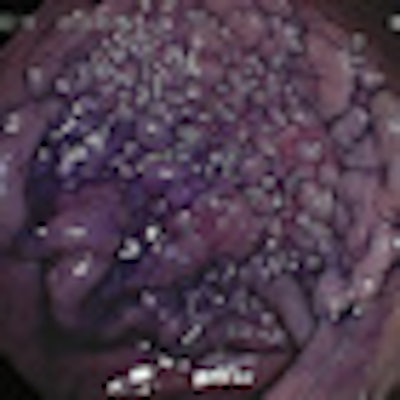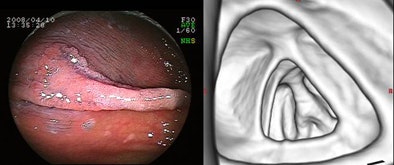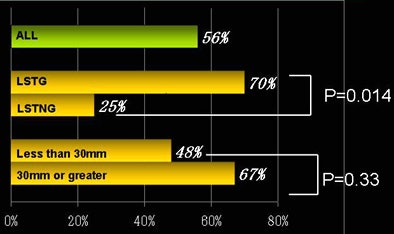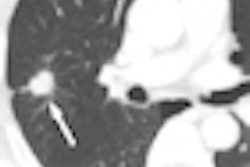
Some lateral spreading tumors (LSTs), more commonly known as carpet lesions, can be hard to spot on virtual colonoscopy, say researchers from Japan, although others say the lesions are readily visible, noting VC's known shortcomings in detecting some flat lesions.
The researchers advise radiologists to be on the lookout due to the lesions' higher-than-average potential for advanced histology. They presented a study on the topic at the European Congress of Radiology (ECR) in March.
"Laterally spreading tumors, characterized by superficial extension along the colonic lumen, are one of the target lesions in colon screening, because more than 20% of LSTs contain high-grade dysplasia," said Dr. Kenichi Utano from Jichi Medical University in Shimotsuke, Japan. "However, it is not clear that [VC] can identify LSTs since the majority reveal a relatively flat appearance."
 |
| Above, 23-mm adenoma (protruding lesion) in the rectum was seen at virtual colonoscopy (right). Below, 20-mm advanced adenoma (flat lesion) was detected only at conventional colonoscopy. All images courtesy of Dr. Kenichi Utano. |
 |
Aiming to determine the VC (also known as CT colonography or CTC) detectability rate for these lesions, Utano and his team prospectively enrolled patients with LSTs measuring 20 mm or greater. The study period was April 2008 to May 2009.
All patients underwent colonoscopy and subsequent CTC on the same day. After colonoscopy, CTC was performed using a 64-detector-row CT scanner without contrast, with patients in the prone and supine positions.
To screen for LSTs, two radiologists blinded to the location, size, and configuration of the LSTs reconstructed virtual endoscopic images. Configuration of LSTs was classified into protruded type (LSTG) and flat type (LSTNG) based upon colonoscopic appearance.
Characteristics of LSTs
|
|||||||||||||||||||||||||||
Only 22 of 39 LSTs were correctly identified by CTC, Utano said. The detection rate of LSTGs was significantly higher than LSTNGs.
"The detectability of LSTs by CTC, particularly the flat type, was not acceptable in spite of advanced lesions," Utano said. "Practitioners should be aware of the high rate of missed lesions in the application of CTC."
 |
| The overall detection rate was only 56%, based on the combined detection rate of 70% for LSTGs and 25% for LSTNGs. There was a significant difference in detectability of the two types by Fisher's exact test (p = 0.014). Interestingly, lesion size was not a significant factor in detectability. |
In an independent commentary, Dr. Perry Pickhardt, professor of radiology at the University of Wisconsin in Madison, took issue with Utano's assessment both of the detectability and the malignant potential of carpet lesions, citing a new study by his team (Academic Radiology, published online March 12, 2010).
Pickhardt and colleagues examined 954 polyps in 5,107 consecutive asymptomatic adults in the prospective study. Of these, 125 lesions (13.1%) in 106 adults were categorized as flat (mean size, 12.7 mm; range, 6-80 mm), which included 73 6- to 9-mm lesions, 42 10- to 29-mm lesions, and 10 carpet lesions 3 cm or larger, only two of which were malignant.
"To date, we have not missed any carpet lesions (LST 30 mm or greater)," Pickhardt wrote in an e-mail to AuntMinnie.com.
"These flat carpet lesions are actually less aggressive compared with polypoid or annular masses of the same size," Pickhardt continued. "Only 20% are malignant, compared with 50% of polypoid masses. Although they are less conspicuous and much less common, they are generally readily detectable at CTC using proper technique. Their clinical importance has therefore been greatly overstated."
Dr. Anno Graser from the University of Munich in Germany commented on the study following the presentation at ECR.
"We all know that we're missing these types of lesions, although we tend to think that they're not as frequent in Western Europe as in [Japan]," Graser said.
An audience member at the presentation noted that 3D visualization can miss flat lesions due to its smoothing of the mucosal surface; 2D is better for detection, he said, and it's especially helpful to use the abdominal window.
By Eric Barnes
AuntMinnie.com staff writer
May 26, 2010
Related Reading
CAD catches most flat polyps on virtual colonoscopy, December 16, 2009
ACRIN: Virtual colonoscopy sensitive for flat polyps, October 13, 2009
Flat-polyp measurements show less variability in 3D VC, September 16, 2009
Virtual colonoscopy CAD improves flat-lesion detection, June 5, 2009
VC's high positive predictive value important for colonoscopy follow-up, April 30, 2009
Copyright © 2010 AuntMinnie.com




















